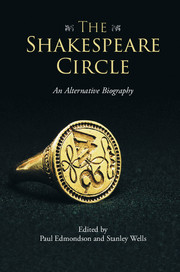Book contents
- Frontmatter
- Contents
- List of illustrations
- List of contributors
- Preface and acknowledgements
- General introduction
- Part I Family
- Part II Friends and Neighbours
- Part III Colleagues and Patrons
- 18 His fellow dramatists and early collaborators
- 19 His theatre friends: the Burbages
- 20 His fellow actors Will Kemp, Robert Armin and other members of the Lord Chamberlain's Men and the King's Men
- 21 His literary patrons
- 22 His collaborator George Wilkins
- 23 His collaborator Thomas Middleton
- 24 His collaborator John Fletcher
- 25 His editors John Heminges and Henry Condell
- Closing remarks
- Afterword
- Index
- References
24 - His collaborator John Fletcher
from Part III - Colleagues and Patrons
Published online by Cambridge University Press: 05 November 2015
- Frontmatter
- Contents
- List of illustrations
- List of contributors
- Preface and acknowledgements
- General introduction
- Part I Family
- Part II Friends and Neighbours
- Part III Colleagues and Patrons
- 18 His fellow dramatists and early collaborators
- 19 His theatre friends: the Burbages
- 20 His fellow actors Will Kemp, Robert Armin and other members of the Lord Chamberlain's Men and the King's Men
- 21 His literary patrons
- 22 His collaborator George Wilkins
- 23 His collaborator Thomas Middleton
- 24 His collaborator John Fletcher
- 25 His editors John Heminges and Henry Condell
- Closing remarks
- Afterword
- Index
- References
Summary
In February 2008 the National Portrait Gallery, London, announced the success of a campaign to raise the money to acquire a portrait of John Fletcher, £2,700 of which was raised by a raffle at Fletcher's House Tea Rooms, in Rye, Sussex, the former vicarage where Fletcher was born (Anon. 2008). While the portrait shows the dramatist at the height of his success in the early 1620s, richly clad and resting his right hand upon a table bearing an inkstand, quill and sheet of paper, the Tea Rooms’ contribution to its purchase recalls his origins. We are used to thinking of Fletcher in terms of ‘– and Fletcher’: ‘Beaumont and Fletcher’; ‘Shakespeare and Fletcher’. The portrait instead reminds us of his independent status and of the distinctive qualities of his family background and upbringing, both important factors if we try to comprehend fully his relationship with Shakespeare.
Fletcher was baptised on 20 December 1579, the fourth child of Richard Fletcher and Elizabeth Holland. Although his background was relatively humble, Richard's eloquence and personal charm helped him to become successively Dean of Peterborough and Bishop of Bristol, Worcester and, in 1594, London. His sons were educated at the Cathedral Grammar School in Peterborough, where John is recorded as one of twenty scholars in 1588 and 1589 (Mellors 1939, pp. xliii–iv). Sir John Harington, no friend of Richard Fletcher, describes him as ‘a comely and courtly prelate’, saying that he ‘could preach well, and would speak boldly, and yet keep decorum … The Queen, as I said, found no fault with his liberal speech’ (Harington 1804: 2, pp. 41, 45). Queen Elizabeth did, however, find fault with his personal life. In 1595, three years after the death of his first wife, Richard married a widow, Mary Baker; the Queen, who disliked married clergymen, suspended him for a brief time, and he had only partially regained her favour by the time of his sudden death in June 1595. Richard's children, and his debts, were left in the hands of his brother Giles, a diplomat with his own court connections.
Little is known of John's life between his father's death and his emergence as a playwright. He had matriculated at Corpus Christi College, Cambridge, in 1591, and Richard's death does not seem to have prevented his graduating with his MA in 1598.
- Type
- Chapter
- Information
- The Shakespeare CircleAn Alternative Biography, pp. 305 - 314Publisher: Cambridge University PressPrint publication year: 2015
References
- 1
- Cited by



